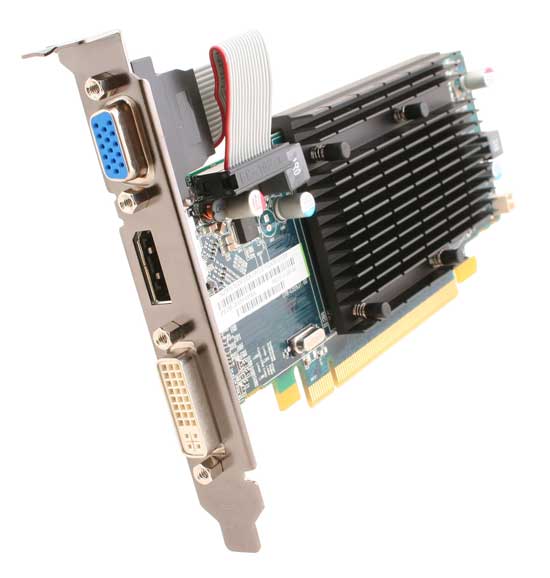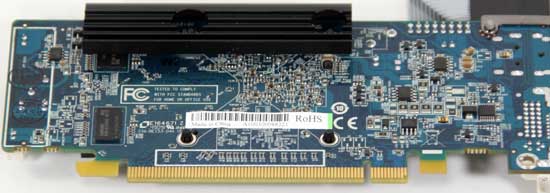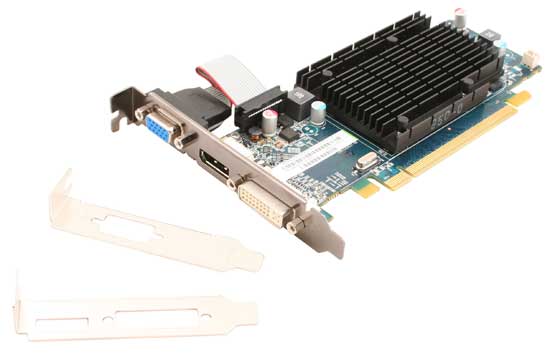AMD’s Radeon HD 5450: The Next Step In HTPC Video Cards
by Ryan Smith on February 4, 2010 12:00 AM EST- Posted in
- GPUs
Meet the Sapphire 5450
Along with our reference card from AMD, Sapphire also sent in their near-reference 5450. As it was clocked correctly at 650MHz/800MHz, we were able to use this card to benchmark the 5450 at its proper clocks, so we’d like to thank Sapphire for sending this in.

The Sapphire 5450 is nearly identical to AMD’s reference card. It uses the same PCB and the same port configuration, and the RAM chips are the appropriate 800MHz Samsung DDR3 chips. The key difference between the two cards is that while AMD is using a double-wide heatsink, the Sapphire 5450 is using a smaller single-wide heatsink. This means that the Sapphire 5450 will fit in to cases where only a single slot’s worth of space is available below the card.

However on the flip side (in all senses of the word) Sapphire’s heatsink wraps around the card slightly, which results in it sticking up from the back side of the card. Technically speaking the heatsink is encroaching on the space that belongs to the card above it, so the Sapphire card won’t fit if there’s a card more than 2 inches long in the slot above it, or if there are tall motherboard components there. In our case it encroached on the audio riser card for our Rampage II Extreme Motherboard. This shouldn’t be a problem for the vast majority of users and is more compatible than a card with a double-wide heatsink, but nevertheless check your case to make sure there’s room for the heatsink on the back side of the card.

As is usually the case with bottom-tier cards, Sapphire packs the 5450 with very little. It comes with a driver CD, the low-profile brackets for the card (it ships with the full-profile bracket installed), an instruction manual, and ArcSoft’s SimHD plugin for upconverting video conferencing feeds. Surprisingly, all of this comes in a full-sized box – this is the first sub-$100 card we’ve seen in some time to not come in a mini-box.
Sapphire also sent along their entire 5450 product chart. Of note, they will be releasing DDR2 and DDR3 cards with HDMI ports that are otherwise identical to today's DisplayPort card, so HTPC users will not be left out in the cold.










77 Comments
View All Comments
Ryan Smith - Thursday, February 4, 2010 - link
That is one of the things that changed. However it's not very resource intensive for the shaders (which is one of the reasons why it was moved in the first place) and I don't seriously suspect that's the cause.andy o - Thursday, February 4, 2010 - link
So far all the 5000 series cards have an issue with PowerPlay. It messes audio especially on Dolby digital and DTS tracks, when DXVA is disabled. When DXVA is enabled the clocks are stabilized (at 400 MHz GPU and 900 MHz memory for the 5770), so Powerplay doesn't screw with the audio. Without using DXVA, the clocks are all over the place (PowerPlay enabled, normally a good thing), and this gives audio dropouts with DD and DTS tracks.Could you test this, with HD videos and DD/DTS tracks? Maybe you'll have a better chance of getting this fixed than a bunch of us just dealing with their horrible support.
Powerplay also triggers funky sound when HDMI is used and 5.1 or 7.1 24-bit 96 kHz or 192 kHz output is set on Windows. Just set it like that and go about your business and you'll hear either crackling or crazy channel switching.
See here for reference, and the following posts of other users who confirm it, and even come up with their own ways to disable Powerplay. This thread at Doom9 was where it was discovered, and later confirmed by nearly everyone who tried (except one strange case or two).
Ryan Smith - Saturday, February 6, 2010 - link
Andy, shoot me an email. I was going to email you, but I'm not sure the address for you in our system actually goes to an account that gets read.andy o - Monday, February 8, 2010 - link
just sent you the email, thanks.PR3ACH3R - Friday, February 5, 2010 - link
[Quote]So far all the 5000 series cards have an issue with PowerPlay. It messes audio especially on Dolby digital and DTS tracks, when DXVA is disabled. When DXVA is enabled the clocks are stabilized (at 400 MHz GPU and 900 MHz memory for the 5770), so Powerplay doesn't screw with the audio. Without using DXVA, the clocks are all over the place (PowerPlay enabled, normally a good thing), and this gives audio dropouts with DD and DTS tracks.
[/quote]
1. ATI & the Review Sites, including Anandtech,
have been ignoring this horrible problem in these cards,
which makes them , for all practical purposes - useless.
But - It does not stop there.
2. The problem you have mentioned with The 57xx series,
creates SERIOUS DPC latencies , especially in XP,
that brakes even the fastest systems, & All audio is full of glitches & clicks chaos.
3. To add insult to injury 2D performance is the worst EVER seen on the PC, beaten even By IGPs.
Bottom Line:
Anadtech yet again fails to detect & report to these issues,
So I would not expect any replies to your questions here.
These cards spell Recall / Class Action all over them.
andyo - Friday, February 5, 2010 - link
Also, I'm not sure what you mean with number 3 (2D performance issues). Could you give some examples so I can test it?PR3ACH3R - Saturday, February 6, 2010 - link
If You do any sort of regular graphics (ignore the IF..)its all 2D ..
After looking hopelessly for ANY solution or even recognition to this problem from professionals, so I can share it, I found there is only one Site with staff professional & unbiased enough to Note the problem.
Not only did they notice it, they published 2 giant articles about it, & it is painfully, obviously, certainly NOT Anandtech.
http://translate.googleusercontent.com/translate_c...">http://translate.googleusercontent.com/...usg=ALkJ...
http://translate.googleusercontent.com/translate_c...">http://translate.googleusercontent.com/...usg=ALkJ...
andyo - Friday, February 5, 2010 - link
It is a big issue, but I'm not sure if it's a hardware problem. It's probably a driver thing.In any case, you can disable Powerplay for the time being, I've done what I linked above and it's working acceptably for me, when I play a game, I'll switch profiles to enable the higher clocks. I'm not sure how it would work on XP though or if the procedure is the same, but you can also use GPU clock tool to stabilize the clocks.
Taft12 - Thursday, February 4, 2010 - link
I have a hard time seeing AMD giving this much attention, the number of users concerned with this issue is infintesimal.Why overclock your GPU when you are focused on the audiophile features? I'll be shocked if the official response is anything other than "Graphics card audio output not supported when Powerplay enabled".
andy o - Thursday, February 4, 2010 - link
Oh and BTW, also as the poster above said, it's not an "audiophile" issue. I actually try to distance myself form that term as much as possible. It's happening whenever DXVA is not enabled, and with DD and DTS audio. As in when playing DVDs with (say) PowerDVD with its post-processing features. Pretty normal scenarios. And it's not a subtle thing. It's dropouts (pops or cut outs in the audio). Also, choppy flash video (shouldn't happen with DXVA accelerated video with flash 10.1 though).Powerplay also triggers horrible crackling and channel switching when output is set to multichannel (5.1 or 7.1) 96 kHz or 192 kHz audio for the Windows mixer. Hardly audiophile issues at all, any of these.